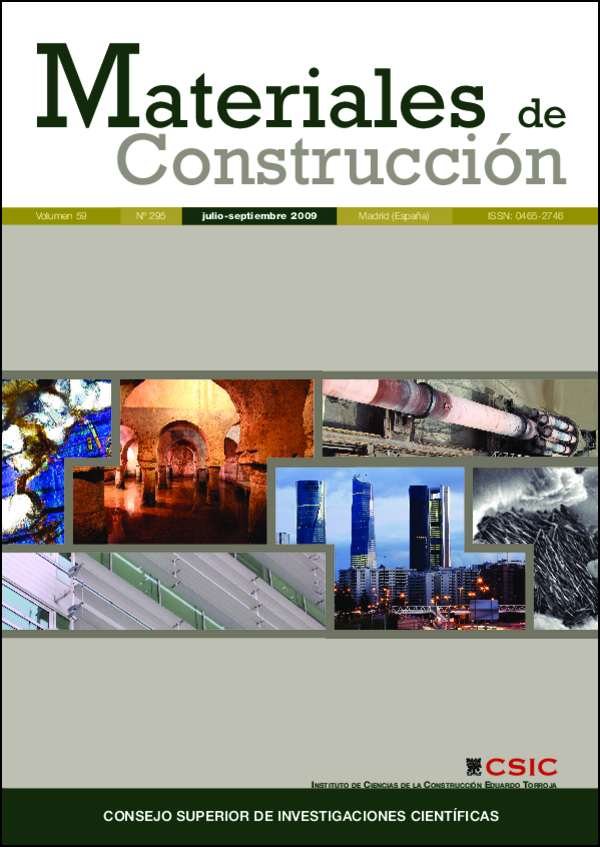Evaluation of isotropy in wet-mix sprayed concrete
DOI:
https://doi.org/10.3989/mc.2009.44607Keywords:
sprayed concrete, wet-mix, compressive strength, module of elasticity, isotropyAbstract
It is well known that there are differences between the fresh mix concrete and the placed concrete sprayed using dry or wet-mix process. Because of that, the characterization of such material is carried out in cores extracted parallel to the spray direction from sample panels. However, in many applications (e.g. tunnel lining), considerable compressive stresses appear along the transversal direction. In this paper different spayed concretes are evaluated. It was observed that the values of compressive strength and modulus of elasticity were different depending on the direction of measurement. These differences are related to a preferential orientation of the coarse aggregate due to the characteristics of the casting process. Rather than applying classic empirical methods, the concrete mixes used in this study were designed according to a new proportioning method based on the difference between the composition of the fresh mix concrete and the placed concrete.
Downloads
References
(1) Fernández Cánovas, M.:“Hormigón Proyectado”, Cemento y Hormigón, nº 877, junio de 2005, pp. 44-57.
(2) Prudencio L. R.: “Contribuçao à dosagem do concreto projetado”, Escola Politécnica, Universidade de Sao Paulo, Tesis doctoral (1993).
(3) Rodríguez, J.: “Estudio relativo a la influencia de distintas variables que inciden en la dosificación y puesta en obra del hormigón proyectado”, ETS Enginyers de Camins, Canals i Ports de Barcelona, Universitat Politècnica de Catalunya, Tesis doctoral (1997).
(4) Martín Lozano, A.: “Hormigón Proyectado: Análisis de la evolución de la vía seca a la vía húmeda”, ETS Enginyers de Camins, Canals i Ports de Barcelona, Universitat Politècnica de Catalunya, Tesina de grado (2003).
(5) American Concrete Institute: Guide to shotcrete, ACI 506R (1990).
(6) García, T.; Agulló, L.; Aguado, A. y Rodríguez, J.: “Propuesta metodológica para dosificación del hormigón proyectado”, Hormigón y Acero 220, 2º trimestre de 2001.
(7) Lascorz, A.: “Estudio relativo al efecto de la incorporación de aditivos químicos de última generación en el hormigón proyectado por vía húmeda”, ETS Enginyers de Camins, Canals i Ports de Barcelona, Universitat Politècnica de Catalunya, Tesina de grado (2001).
(8) American Shotcrete Association Q 67: http://www.shotcrete.org/ASAfaqs.htm
(9) AENOR, UNE 83602: “Hormigón y mortero proyectados. Preparación de la muestra para obtención de probetas testigo” (1997).
(10) UNE 83605:“Hormigón y mortero proyectados. Obtención, preparación y ensayo a compresión o tracción de probetas testigo” (1991).
Downloads
Published
How to Cite
Issue
Section
License
Copyright (c) 2009 Consejo Superior de Investigaciones Científicas (CSIC)

This work is licensed under a Creative Commons Attribution 4.0 International License.
© CSIC. Manuscripts published in both the print and online versions of this journal are the property of the Consejo Superior de Investigaciones Científicas, and quoting this source is a requirement for any partial or full reproduction.
All contents of this electronic edition, except where otherwise noted, are distributed under a Creative Commons Attribution 4.0 International (CC BY 4.0) licence. You may read the basic information and the legal text of the licence. The indication of the CC BY 4.0 licence must be expressly stated in this way when necessary.
Self-archiving in repositories, personal webpages or similar, of any version other than the final version of the work produced by the publisher, is not allowed.
















